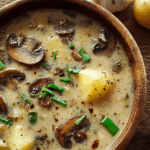Cacio e Pepe is the epitome of Italian simplicity, using just a handful of ingredients to create a comforting and luxurious dish. The Pecorino Romano melts beautifully into the warm pasta, forming a creamy sauce that’s rich and velvety, while the black pepper adds the perfect amount of spice.
This dish is the perfect example of how less is more. With only a few ingredients, you can create a meal that’s both satisfying and flavorful. Whether you’re enjoying it as a quick weeknight dinner or serving it at a special dinner party, Cacio e Pepe is sure to impress. It’s the kind of dish that invites you to slow down and savor every bite, making it a true comfort food favorite.
Full Recipe:
- 400g spaghetti
- 150g Pecorino Romano, freshly grated
- 2 tablespoons freshly cracked black pepper
- 2 tablespoons unsalted butter
- 1 tablespoon olive oil
- Salt to taste
- 1/2 cup reserved pasta cooking water
Directions:
- Bring a large pot of salted water to a boil and cook the spaghetti according to package directions, or until al dente.
- While the pasta is cooking, heat the olive oil and butter in a large skillet over medium heat.
- Add the cracked black pepper to the skillet and toast it for 1-2 minutes, or until fragrant.
- Once the pasta is done, reserve about 1/2 cup of the pasta cooking water, then drain the pasta.
- Add the drained pasta to the skillet with the black pepper and toss to coat.
- Slowly add the reserved pasta water to the skillet, tossing the pasta to create a silky sauce.
- Remove the skillet from heat and gradually stir in the grated Pecorino Romano cheese until it melts into the sauce, creating a creamy coating on the pasta.
- Season with additional salt and pepper to taste.
- Serve immediately with extra Pecorino Romano on top, if desired.
Prep Time: 5 minutes | Cooking Time: 10 minutes | Total Time: 15 minutes
Kcal: 350 kcal | Servings: 2 servings
Cacio e Pepe: A Timeless Roman Classic
Cacio e Pepe, a traditional Italian pasta dish, is a true testament to the idea that simplicity often yields the most satisfying results. The name itself, which translates to “cheese and pepper,” perfectly encapsulates the essence of this dish. Despite being incredibly simple, Cacio e Pepe has become one of the most beloved and iconic dishes in Roman cuisine. Its roots run deep in the culinary traditions of Rome, where it has been prepared for centuries. But beyond its history, this dish embodies the beauty of minimalism, relying on just a few basic ingredients to create something extraordinary.
In this article, we will dive into the history, cultural significance, variations, tips for perfecting this dish, and why Cacio e Pepe continues to hold a special place in the hearts of food lovers worldwide.
The Origins of Cacio e Pepe
The origins of Cacio e Pepe trace back to the rustic kitchens of ancient Rome, where it was a dish designed for simplicity and practicality. Romans, particularly shepherds, were known to travel long distances across the hills of Lazio, and their diet consisted of easy-to-carry, non-perishable ingredients that could withstand the rigors of travel. Pecorino Romano, a sheep’s milk cheese, was a staple of this diet, as it was hearty and could be stored for long periods. Similarly, black peppercorns were also preserved well and could be easily carried in the travel bags of the Roman shepherds.
The combination of these two ingredients, along with the addition of pasta, became the basis for Cacio e Pepe. The dish was born out of necessity but quickly grew into a beloved classic. What was initially a humble meal for shepherds has evolved into a sophisticated and cherished Italian dish.
Cacio e Pepe is often considered a quintessential example of “cucina povera” (poor kitchen) — a term used to describe traditional Italian recipes made with few, simple ingredients. Despite its modest origins, the dish has transcended its humble beginnings and is now a star on menus both in Italy and internationally.
Why is Cacio e Pepe So Special?
At first glance, Cacio e Pepe might seem too simple to be considered anything remarkable. After all, it consists of just three main ingredients: pasta, Pecorino Romano cheese, and black pepper. However, it is this simplicity that makes it special. When prepared correctly, the dish is a perfect balance of flavors — the creamy, salty Pecorino Romano and the sharp, earthy black pepper come together with the pasta to create something truly exceptional.
The key to a successful Cacio e Pepe lies in technique. The pasta must be cooked to perfection, not too soft or too al dente, and the pasta water — the starchy liquid leftover from cooking — plays an essential role in creating a smooth, creamy sauce. This combination of cheese, pepper, and pasta water forms a silky, rich coating that clings to each strand of pasta. When done right, Cacio e Pepe becomes a luxurious, velvety dish that belies its simplicity.
The Art of Making Cacio e Pepe
Making Cacio e Pepe requires a delicate touch. The dish may be made with just a handful of ingredients, but it demands attention to detail at every step.
- The Pasta: Spaghetti is the traditional choice for Cacio e Pepe, but other pasta shapes like tonnarelli or bucatini can also be used. The most important aspect of the pasta is that it must be cooked in salted water until it’s perfectly al dente. The starchy cooking water is essential to help create the sauce, so be sure to reserve a generous amount before draining the pasta.
- The Pecorino Romano Cheese: Pecorino Romano is a firm, salty cheese made from sheep’s milk. It has a sharp, tangy flavor that melts beautifully into the sauce. The key is to use freshly grated Pecorino Romano to achieve the best texture and flavor. Pre-grated cheese will not melt in the same way and can result in a grainy sauce.
- Black Pepper: Freshly cracked black pepper is essential for this dish. It should be toasted lightly in a pan to bring out its full flavor before being mixed with the pasta. A liberal amount of black pepper is what gives Cacio e Pepe its characteristic warmth and spice.
- Pasta Water: The reserved pasta water is used to help emulsify the sauce. It’s the secret ingredient that brings everything together, giving the cheese and pepper something to cling to. The starch in the water helps bind the cheese into a creamy sauce, creating that silky texture that makes this dish so irresistible.
Variations of Cacio e Pepe
While the traditional recipe is cherished for its simplicity, there are several variations that add new twists to this classic dish.
- Cacio e Pepe with Lemon: Some variations include a hint of lemon zest, which adds a fresh, bright flavor that balances the richness of the Pecorino Romano and the spice of the black pepper.
- Cacio e Pepe with Truffle: For a more indulgent take on the dish, truffle oil or fresh truffles can be added. The earthy flavor of the truffle complements the rich cheese and pepper, elevating the dish to a whole new level of sophistication.
- Cacio e Pepe with Cream: Though not traditional, some people add a little cream to the sauce to make it even creamier. This version softens the sharpness of the Pecorino Romano and creates a luscious, indulgent sauce.
- Vegan Cacio e Pepe: For a dairy-free version, vegan cheeses such as cashew-based or coconut-based cheeses can be substituted. Vegan butter or olive oil can be used in place of traditional butter to create a rich and creamy sauce without any animal products.
- Cacio e Pepe with Vegetables: Another popular variation is to incorporate vegetables, such as asparagus, peas, or roasted tomatoes. These additions add both flavor and color to the dish while still maintaining the simplicity of the original recipe.
Cultural Significance of Cacio e Pepe
Cacio e Pepe holds a special place in Italian culinary culture. It is not just a dish; it’s a symbol of the Italian approach to cooking — making the most of what you have and turning simple ingredients into something extraordinary. It’s a dish that reflects the Italian love for simplicity and authenticity, using just a few key ingredients to create a meal that’s both satisfying and delicious.
In Rome, Cacio e Pepe is often enjoyed as a quick meal at lunch or as a comforting dinner. It’s a dish that’s often associated with family meals, shared among loved ones in a cozy setting. The simplicity of Cacio e Pepe makes it perfect for busy weeknights when you don’t have a lot of time to cook but still want something flavorful and fulfilling.
Moreover, Cacio e Pepe has become a beloved dish far beyond Rome. With its growing popularity worldwide, it’s now served in Italian restaurants across the globe. Despite its humble origins, it has found a place in the hearts of food enthusiasts and home cooks everywhere.






